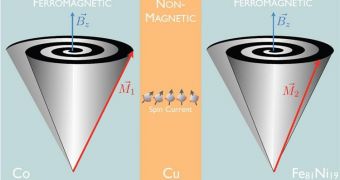German scientists at the Ruhr University Bochum (RUB) have demonstrated for the first time ever that the spin pumping effect affecting magnetic layers can exist in reality. The concept was thus far only a theoretical construct, but the team's experiments proved that it actually exists.
Thanks to the new advance, it may be possible to create a new generation of magnetic sensors in hard disk (HDD) read heads and other data storage devices, the experts say. The effect was measured using ultrafast X-ray scattering, with picosecond resolution.
The researchers, led by physicist professor Dr. Hartmut Zabel, say that electrons can influence each other's spin through a non-magnetic, intermediate layer between two magnetic moments. This so-called magnetic precession is caused by the electrons themselves.
Details of the study appear in a paper published in the latest issue of the esteemed journal Applied Physics Letters, AlphaGalileo reports. The team says that its research was focused on analyzing the behaviors of spinning tops.
The experts say that spinning tops put into motion and left unattended have a tendency to slow down their motion and come to a halt after only a few spins. The same effect can be noticed when two of them are placed in a system at distance from each other, avoiding contact.
Even then, the team says, both spinning tops display the same behavior. What the spin pumping effect held was that one of the two tops should theoretically be able to influence the rotation of the other.
In the new experiments, the team did “not expect that one spinning top can affect the rotation of the other. But that's precisely what happens with magnetic spinning tops,” the team leader explains.
“Ferromagnetic layers, which do not interact with each other statically because the intermediate layer is too thick, are still able to 'affect' each other dynamically through pumping and diffusion of spins from one layer to another,” a press release accompanying the findings indicate.
However, this only happens if the magnetic spin tops are engaged in a very fast precession in the gigahertz range. Another condition is for the two ferromagnetic layers to be separated by a copper layer thick enough to ensure no static energy is exchanged between them.
“Therefore, the finding that the damping of the magnetic precession is influenced by spin pumping through non-magnetic intermediate layers is not only of fundamental but also of practical interest for industrial applications,” Zabel concludes.

 14 DAY TRIAL //
14 DAY TRIAL //